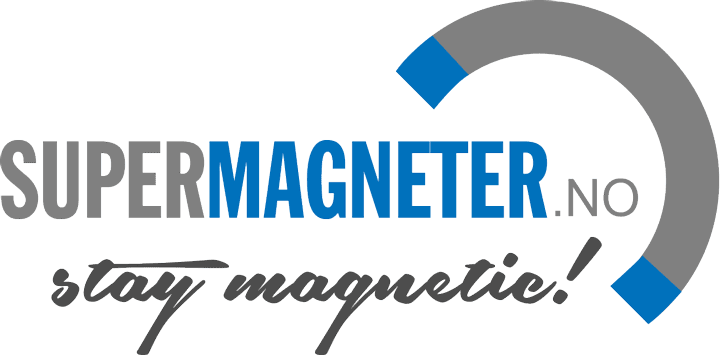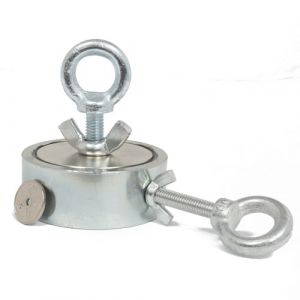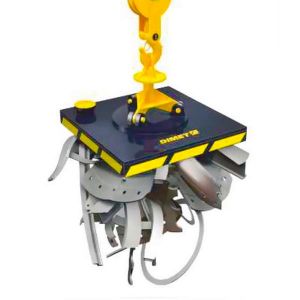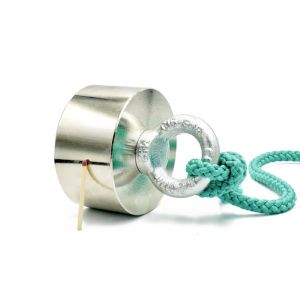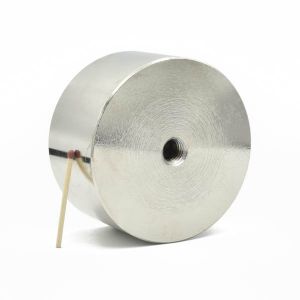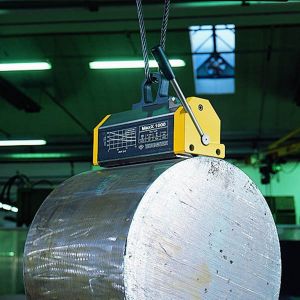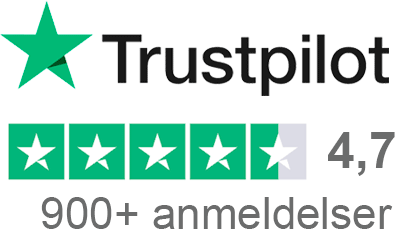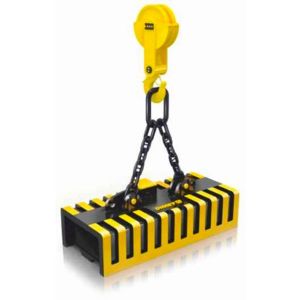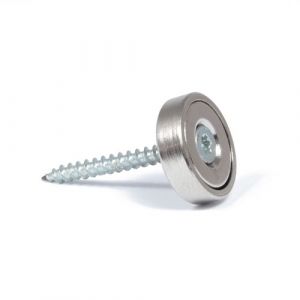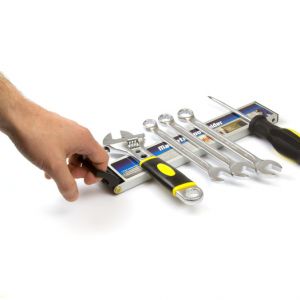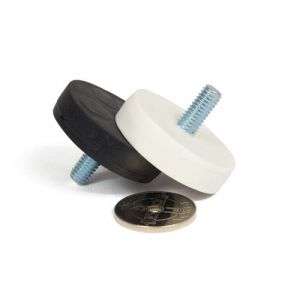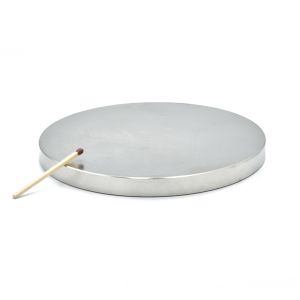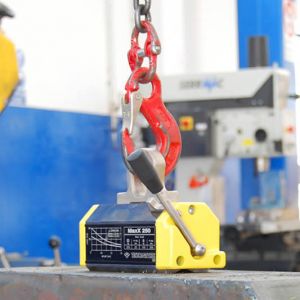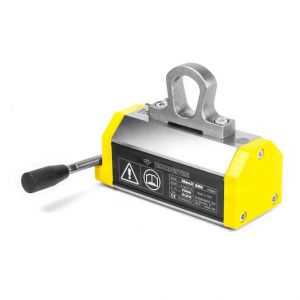Løftemagnet 1000kg kapasitet
Løftemagnet med 1000 kg /1 tonn kapasitet | Manuelt betjent
Sikker og sterk løftemagnet.
Se en annen løftemagnet med løftekapasitet 1000 kilo - ProLM 1000 kg
Vennligst kontakt oss dersom du ønsker å bestille denne varen.

Se en annen løftemagnet med løftekapasitet 1000 kilo - ProLM 1000 kg
Løftemagneten leveres med bruksanvisning på engelsk.
- Sikkerhetsfaktor på 3.5 : 1
- Manuelt betjent
- Vekt 40 kg
Nominal hoisting capacity: 1000 [kg]
Maximal hoisting capacity: >3500 [kg] – safety coefficient for static tests is 3,5.
DO NOT LIFT LOADS THAT ARE HEAVIER THAN THE NOMINAL HOISTING CAPACITY !
Lifting magnets are magnetic systems assembled by incorporation of stable magnets. They are used for lifting and moving heavy iron and magnetic steel elements. Devices of this kind do not require any external nor internal power supply. Magnetic field is switched on and off as a result of adjustment with a hand-operated lever. The lifting magnets’ magnetic field is produced by sintered neodymium magnets of the latest generation. Thanks to their reduced dimensions and relatively small weight they are very handy and user-friendly. Lifting magnets may prove to be very useful in steel depots, plants, warehouses, workshops, docks and wherever they may be of service while moving items such as pipes, metal sheets and plates, as well as other large iron elements. Lifting magnets with CM series come with an two-year guarantee and "CЄ" compliance declaration.
Hoisting capacity of each lifting magnet depends on the following factors:
thickness and form of an element lifted (for each lifting magnet dependence of hoisting capacity in relation to lifted elements thickness is given). For pipes and rollers nominal hoisting capacity is reduced by approx. 50 per cent. The minimum thickness of an element for CM1000 is 10 mm,
Elements which are too thin can be attracted too weakly as the lifting magnet’s magnetic field is not used fully. Only a small fraction of the magnetic field is enough to saturate very thin metal sheet, while bigger part of magnetic flux penetrates out of the sheet to the environment. In case like that the lifting magnet’s magnetic circuit is not optimally compact. Moreover, thin elements tend to change their shape and their surface of contact with the lifting magnet becomes linear, which reduces dramatically the hoisting capacity strength. The most effective hoisting capacity comes with adequately thick elements that close the magnetic circuit properly, using all the magnetic flux of the lifting magnet. The following template gives optimal thickness of lifted elements for each type of the lifting magnets (i.e. thickness for which hoisting capacity efficiency is 100%).
Thickness of lifted element with which hoisting capacity of lifting magnet remains 100% is 40 mm
Before starting of work carefully consider per cent dependency of hoisting capacity as function of the lifted steel (efficiency of hoisting capacity curves may be found in a lifting magnet housing).
size of an air gap comprised between the lifting magnet surface and surface being lifted (for each lifting magnet characteristics of hoisting capacity as function of air gap size is given),
| Steel thickness
|
Non-magnetic gap between the lifting magnet poles and lifted element
|
|||
| D = 0 mm | D = 0,1 mm | D = 0,3 mm | D = 0,5 mm | |
| Nominal hoisting capacity of lifting magnet [kg] | ||||
| 50 | 1000 | 930 | 761 | 500 |
| 40 | 963 | 896 | 733 | 482 |
| 30 | 905 | 842 | 689 | 453 |
| 20 | 848 | 789 | 645 | 424 |
| 10 | 720 | 670 | 548 | 360 |
The hoisting capacity depends on air gap comprised between magnet legs of the lifting magnet and a lifted element. If surface unevenness of a load R is smaller than 6,3 mm, the air gap next to the lifting magnet surface disappears and the hoisting capacity efficiency is not decreased. Such is the case with very clean, flat and polished surface. If, however, surface unevenness of lifted materials Ra is bigger than 6,3 mm, the air gap between the lifting magnet and element lifted should be considered. For rusted surfaces after rolling we may allow an air gap in a range of (0,1-0,3 mm), while for uneven porous surfaces the air gap may be predicted in a range of (0,3-0,5 mm).
Before starting of work find information about per cent dependency of hoisting capacity as function of the air gap (efficiency of hoisting capacity curves may be found in a lifting magnet housing).
quality of lifted steel (generally, the bigger proportion of iron, the bigger hoisting capacity: efficiency of hoisting capacity coefficient for low-carbon steels is 1,0 ; for high-carbon steels - 0,90; for low-alloyed steels - 0,75; for cast iron 0,50),
Different ferromagnetic materials react with magnets in a different way (they have particular magnetic properties). Some of them are attracted more intensively, others – less intensively. This depends on structure as well as chemical composition of a given material. For example, pure iron (Armco) is attracted more strongly than carbon steels, and carbon steels are attracted more strongly than cast iron.
| Name | Nominal hoisting capacity[kg] | Capacity limit for the material *)[kg] | |||
| Steel(low carbon) | Steel(high-carbon) | Steel(low-alloyed) | Cast iron | ||
| Lifting magnet 1000kg | 1000 | 1000 | 900 | 750 | 500 |
*) such is admissible hoisting capacity for an element made of given material provided it is not decreased by additional factors (thickness, surface quality, shape).
environmental temperature as well temperature of lifted elements (it cannot be higher than 80oC).
Lifting magnets from CM series are not classified as a source of noise – their level of acoustic pressure does not exceed 70 [dB].
| SKU | SM-00189 |
|---|---|
| Vekt | 40 kg |
| EAN | 7073330001897 |
| Styrke | 1000 kg |
| Maks. temperatur | 80°C |
| Håndtak lengde | 300 mm |
| Total høyde | 145 mm |
| Bredde | 145 mm |
| Lengde | 272 mm |
